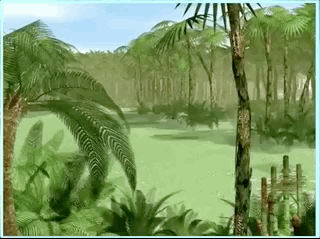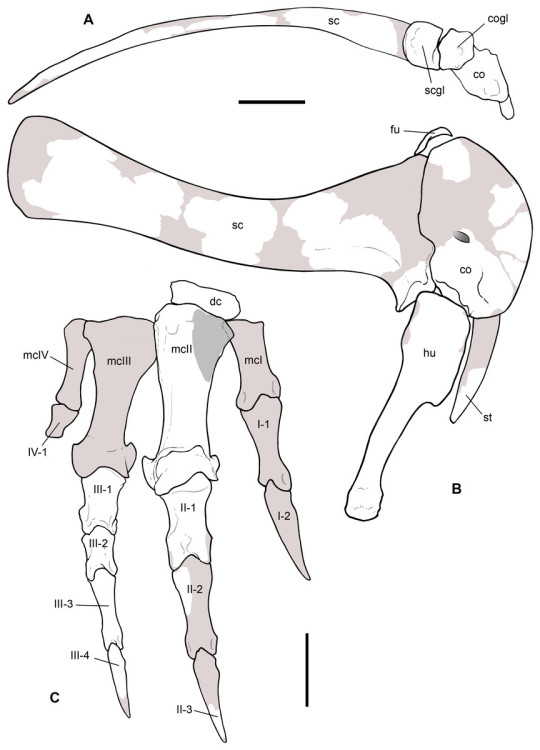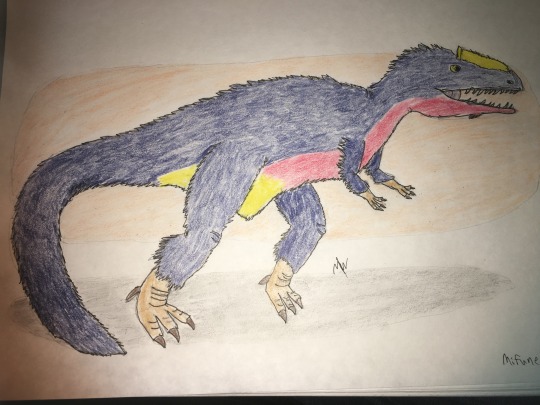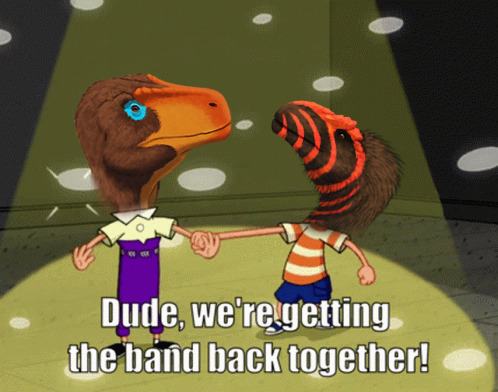#ceratosaurids
Text
Dinofact #51
Although they are, at first glance, very similar, a major difference between Ceratosaurs and Tyrannosaurids is the number of digits in the hand. While Tyrannosaurids were characterised by having only two functional fingers in each hand, Ceratosaurs notably kept all four.
Source: wikipedia [1], [2], [3]
#dinosaur#dinosaurs#paleontology#tyrannosaurid#tyrannosaurids#tyrannosauridae#ceratosaurids#ceratosaurs#ceratosaur#ceratosaurid#ceratosaurus#ceratosauria#theropods#theropod#theropoda#fun facts#trivia#dinosaur trivia#dinosaur fun facts#14th#october#2022#october 14th#october 2022#october 14th 2022
17 notes
·
View notes
Text

A dinosaur tooth of an indeterminate ceratosaurid, possibly cf. Ceratosaurus sp. from the El Mers Group in Boulahfa, Boulamane, Morocco. The pronounced ridges that run down the tooth is a characteristic seen in Ceratosaurus. While ceratosaurids are a very early diverging group of theropod, few species are described, none of which are from the Middle Jurassic or older. Although comparable, it is unknown if these fossils could belong to Ceratosaurus sp., or if they represent a new undescribed genus.
#dinosaur#fossils#paleontology#palaeontology#paleo#palaeo#ceratosaurus#ceratosauridae#theropod#jurassic#mesozoic#prehistoric#science#paleoblr#ケラトサウルス#ケラトサウルス科#恐竜#化石#古生物学
45 notes
·
View notes
Text
It Came From The Wastebasket #12: Coelurosaur Confusion
Historically Coelurosauria was the counterpart to the Carnosauria, with both of them representing two major lineages of theropod dinosaurs.
Created as a group in the early 20th century, coelurosaurs quickly became a dumping ground for all small-bodied theropods – including coelophysoids, compsognathids, ornithomimids, oviraptorosaurs, dromaeosaurids, and troodontids– and for a while this wastebasket taxon also included the large-bodied ceratosaurids and tyrannosauroids, before they were moved over into the carnosaurs.
But during the 1960s and 1970s this arrangement began to break down. A better understanding of groups like dromaeosaurs revealed a confusing mixture of traditional "carnosaur" and "coelurosaur" anatomical features, and paleontologists struggled to figure out where these sorts of theropods actually fit in.
The development of cladistic methods from the 1970s onwards led to efforts to clean up the coelurosaur wastebasket, trying to figure out a more accurate version of these animals' evolutionary relationships. After briefly collapsing Coelurosauria down to just coelophysoids and "coelurids", the growing recognition of modern birds as living theropod dinosaurs eventually resulted in the group being properly redefined in the 1980s as "birds, and all theropods closer related to them than to carnosaurs".

Clockwise from the left (not to scale): Citipati osmolskae, Albertosaurus sarcophagus, Yi qi, Sinosauropteryx prima
The coelophysoids were finally removed entirely, reclassified as a much earlier branch of theropods – but quite a few of the other groups from earlier concepts of Coelurosauria survived this reshuffling, with the compsognathids, ornithomimids, oviraptorosaurs, dromaeosaurs, and troodontids all proving themselves to have really been closely related the whole time. Meanwhile the tyrannosauroids were brought back in, along with the therizinosaurs, alvarezsauroids, and a whole bunch of paravian and avialan lineages.
(Megaraptorans might belong somewhere in the coelurosaurs, too – possibly being tyrannosauroids – but their classification is currently being disputed.)
———
Nix Illustration | Tumblr | Twitter | Patreon
#it came from the wastebasket#wastebasket taxon#taxonomy#coelurosauria#theropod#dinosaur#paleontology#art#science illustration#paleoart#palaeoblr
231 notes
·
View notes
Text
Dandakosaurus Indicus

Dandakosaurus was a large carnivorous theropod, wait let me rephrase that, the FIRST large theropod to ever walk the earth. This Early Jurassic theropod was the first to ever exceed 2 tons, making it a truly exceptional predator. Like, for reals can we step back from the massive Tyrannosaurids/Carcharodontosaurids, and appreciate its magnificence? Like, it really said go big or go home for reals. However, with all that being said, the dinosaur is known from extremely fragmentary remains unfortunately. The holotype, GSI 1/54Y/76, only contains a pubis, which leads many paleontologists to question its existence. If it did truly in fact walk the face of the earth at some point, then it will forever be remembered in hostory as the first large theropod.
Stats:
Length: ~33ft (10 m)
Height: ~13ft (4 m)
Weight: ~2.3 tons (4600 lbs)
Area: Andhra Pradesh (India)
Time: 200-182 mya
Formation: Kota Formation of India
Family: Averostran/primitive Tentanuran/ Ceratosaurid.
Species: D. Indicus
#dinosaur#paleoart#dinos and comics#art#artwork#dinosaurs#dinovember#allosaurid#carcharodontosauridae#theropod#tyrannosaurid#dinosaureggs brachiosaurus tyrannosaurus triceratops ankylosaurus stegosaurus velociraptor trex babydinosaur#tyrannosaurus rex#tyrannosauroidea#t. rex
15 notes
·
View notes
Text

Ceratosaurus
...................................................................
It is an extinct genus with three species of ceratosaurid theropod dinosaur, which lived at the end of the Jurassic period, approximately 153 and 148 million years ago, in the Kimmeridgian and the Titonian, in what is now North America, Africa, Uruguay and Europe.
...................................................................
Body mass: 520 kg
Family: Ceratosauridae
Class: Sauropsidai
Genus: Ceratosaurus; Marsh, 188
...................................................................
...................................................................
1 note
·
View note
Text
Daily Dinosaur Fact: Day 7

Ceratosaurus isn’t actually horned. The lumps on its heads are in fact crests, and were most likely used as a form of display.
#Daily#Dinosaur#Dinosaurs#Fact#Facts#Day7#Crests#Horns#Display#Head#HeadOrnament#HeadOrnaments#HeadOrnamentation#Ceratosaurus#Ceratosaurid#Ceratosauridae#Ceratosaur#Ceratosauria#Averostran#Averostra#Neotheropod#Neotheropoda#Theropod#Theropoda#Saurischian#Saurischia
4 notes
·
View notes
Text

Saltriovenator zanellai fu un grosso teropode ceratosauro vissuto in Italia 200 milioni di anni fa. Ad oggi è il più antico ceratosauride conosciuto. Lungo sino a 8 m questo dinosauro era certamente uno dei massimi predoni del suo habitat.

Maggiori informazioni al link seguente:
30 notes
·
View notes
Note
I know you classify Uragaan and Duramboros as ornithischians, but what would you classify Brachydios as?
It’s hard to give a classification to such a heavily armored animal …
So let’s peel back the layers, shall we?

(This selection from Brachydios’s ecology booklet isn’t the greatest in terms of real world anatomy, but we can absolutely use it for our purposes)
Now, as we can see, a lot of what apparently makes Brachydios Brachydios is a lot of keratin!
But sure enough, it is in fact a theropod. Looking at its tall neural spines, thick scapula, small pubis, and elaborate head ornamentation, I could conclude that Brachydios is a highly derived ceratosaurid.
90 notes
·
View notes
Text
Ceratosaurus a fost un gen de dinozauri teropod ceratosaurid care a existat planeta noastră în perioada jurasică, acum aproximativ 150 de milioane de ani.
0 notes
Text
“Mifunesaurus”

By Max Wipson on @plokool
PLEASE SUPPORT US ON PATREON. EACH and EVERY DONATION helps to keep this blog running! Any amount, even ONE DOLLAR is APPRECIATED! IF YOU ENJOY THIS CONTENT, please CONSIDER DONATING!
Name: “Mifunesaurus”
Name Meaning: Mifune Reptile
First Mentioned: 1985
Mentioned By: Hisa
Classification: Dinosauria, Theropoda, Neotheropoda, Averostra, Tetanurae
“Mifunesaurus” is an unofficial name for a tooth found in the Kabu Formation of the Mifune Group of Japan. It lived in the Middle Cenomanian age of the Late Cretaceous, sometime around 96 million years ago. The tooth was originally named in a booklet on dinosaurs, and then later described in detail, but neither description was formal enough for an official name of the tooth. It was too thick to be the tooth of a Ceratosaurid, and too tall to be that of an Abelisaurid, so it is probably a tooth of a Megalosauroid or a Carnosaur.
Source:
http://theropoddatabase.com/Tetanurae.htm#Mifunesaurus
This is your friendly reminder that ADAD relies on reblogs up and until @staff gets it’s shit together. Please reblog this post.
Shout out goes to @lietome-tellmeimperfect-blog!
#mifunesaurus#dinosaur#theropoda#palaeoblr#prehistoric life#lietome-tellmeimperfect-blog#paleontology#prehistory#dinosaurs#biology#a dinosaur a day#a-dinosaur-a-day#dinosaur of the day#dinosaur-of-the-day#science#nature#factfile#Dìneasar#דינוזאור#डायनासोर#ديناصور#ডাইনোসর#risaeðla#ڈایناسور#deinosor#恐龍#恐龙#динозавр#dinosaurio#공룡
34 notes
·
View notes
Text
Dinofact #40
Proceratosaurus, a small theropod carnivore, was originally thought to be an ancestor of Ceratosaurus, due to the crest on its head resembling that of Ceratosaurus. However, it is now considered a coelurosaur, specifically a member of Proceratosauridae, whereas Ceratosaurus is a Ceratosaurid. Proceratosaurus may be one of the earliest members of Tyrannosauroidea.
Source: wikipedia [1], [2]
#dinosaur#dinosaurs#paleontology#proceratosaurus#ceratosaurus#theropod#theropods#theropoda#coelurosaur#coelurosaurid#coelurosauria#tyrannosaur#tyrannosauroidea#tyrannosauroids#tyrannosauroid#ceratosaurid#ceratosaurids#ceratosauridae#ceratosauria#fun facts#trivia#dinosaur trivia#dinosaur fun facts#3rd#october#2022#october 3rd#october 2022#october 3rd 2022
8 notes
·
View notes
Text
It Came From The Wastebasket #07: Carnosaur Carnage
Carnosauria was originally named in the 1920s as a grouping for all of the large-bodied theropod dinosaurs known at the time.
For much of the 20th century it was used as a general wastebasket taxon collecting together all big carnivorous forms – including allosaurids, carcharodontosaurids, megalosaurids, spinosaurids, ceratosaurids, abelisauroids, and tyrannosaurids – and for a while it even included a species that later turned out to be closer related to crocodiles than to dinosaurs.

From left to right: Asfaltovenator vialidadi, Torvosaurus tanneri, Giganotosaurus carolinii, & Baryonyx walkeri
But then cladistic analysis in the 1980s and 1990s revealed that some of these theropods weren't actually closely related at all. Carnosaurs weren't a natural lineage but instead were highly polyphyletic, with the physical similarities between them seeming to be more due to convergent evolution than direct shared ancestry.
Some carnosaurs were split off and reclassified as more "primitive" types of theropod, while the tyrannosaurs were placed much closer to birds with the coelurosaurs. The remaining "carnosaurs" were just the allosaurids, carcharodontosaurs, and their closest relatives, and some paleontologists now prefer to use the name Allosauroidea for this group to distance it from the previous wastebasket mess.
…But Carnosauria might not be done just yet.

The discovery of Asfaltovenator in 2019 complicated matters once again, with a mixture of anatomical features linking it to both the allosauroids and the megalosauroids (megalosaurids, spinosaurids, and their relatives) – suggesting that these two groups might actually have been closely related to each other in a single lineage after all.
This would potentially return Carnosauria back to something surprisingly close to its original definition, with the various megalosauroids now forming an evolutionary grade leading to the allosauroids.
———
Nix Illustration | Tumblr | Twitter | Patreon
#it came from the wastebasket#wastebasket taxon#taxonomy#carnosaur#asfaltovenator#torvosaurus#giganotosaurus#baryonyx#theropod#dinosaur#paleontology#art#science illustration#paleoart#palaeoblr
338 notes
·
View notes